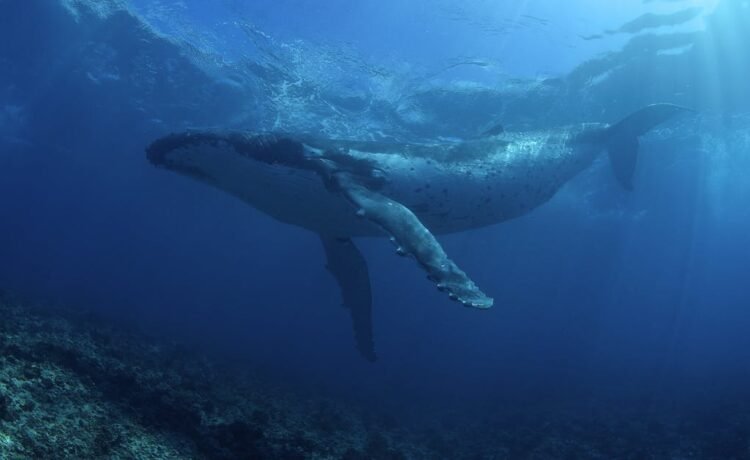Protecting nature starts with science. Here’s a roundup of recent scientific research published by Conservation International experts.
1. An effective strategy to protect a high seas hotspot
More than 60 percent of the world’s oceans lie beyond the jurisdiction of any nation — an area commonly known as the “high seas.”
However, only about 1 percent of this vast and largely unexplored expanse is protected.
In a new report, a team of ocean experts outlines the importance of creating a high seas marine protected area in one of the most unique biodiversity hotspots on Earth: the Salas y Gómez and Nazca ridges.
Located in international waters off the coasts of Peru and Chile, these underwater mountain chains stretch 2,900 kilometers (1,800 miles) across the southeastern Pacific Ocean and provide critical habitat and migratory routes for a variety of marine life, including whales, leatherback sea turtles, corals and hundreds of other marine species.
“Although Peru and Chile have recently taken steps to protect areas within their waters, more than 73 percent of the Salas y Gómez and Nazca ridges lie outside of national jurisdiction,” said Daniel Wagner, Conservation International ocean scientist and the lead author of the report. “This means that the majority of these habitats — and the many species they support — are largely unprotected.”
And according to Wagner, the Salas y Gómez and Nazca ridges face looming threats.
“Overfishing, climate change and deep-sea mining could have a profoundly negative impact on this region,” Wagner added. “So far, commercial fishing has been limited in the Salas y Gómez and Nazca ridges, and deep-sea mineral exploration has not yet occurred, providing a window of opportunity to protect this area without significantly impacting those industries.”
Co-authored by 27 leading experts in ocean science, policy and law, the report found that the most effective strategies to protect the Salas y Gómez and Nazca ridges include limiting fishing activities, prohibiting seabed mining and establishing a high seas marine protected area in the region.
“Not only is this area a biodiversity hotspot, it is also culturally significant as Polynesian and other seafarers have sailed across it on their way to South America for centuries.” said Wagner. “Due to their exceptional natural and cultural significance, these ridges are one of the most important high seas areas to protect globally.”
2. Conserving wildlife — and the roles they play in nature — to improve ecosystem health
Deforestation, the global wildlife trade and other human activities are decimating species around the planet.
According to a new study, they are also eliminating the critical functions that native wildlife and plants provide for healthy ecosystems.
“Simply counting the number of species in a tropical forest does not provide a full picture of the biodiversity in that ecosystem,” said Jorge Ahumada, a wildlife scientist at Conservation International and co-author on the study.
“From small birds to massive carnivores, every native species has its own niche in an ecosystem based on traits such as its size, diet or reproductive habits. If a species disappears from an area, its absence could create a domino effect that impacts the broader ecosystem. We need to better understand the ramifications of local species loss.”
To do this, the researchers first analyzed wildlife photos from 15 protected areas in tropical forests around the world, including in Asia, Africa and South America. The photos were pulled from the Tropical Ecology Assessment and Monitoring Network, which uses motion-detector cameras to monitor global species trends in tropical forests.
Then, they studied the known traits of each of these species and compared them to the traits of other species in that area, calculating what is known as an ecosystem’s “functional diversity” — the variety of roles species play in their habitats.
The study’s authors concluded that destructive human activities decrease the diversity of species’ traits in an area, which can have particularly profound impacts on an ecosystem’s food chain.
“We found that in areas where local species extinctions have been documented due to significant deforestation or poaching, such as in Korup National Park in Cameroon, large carnivores like leopards and golden cats are the first to go,” he said. “Without these apex predators, entire food chains can be thrown out of balance. Eventually populations of smaller herbivores will skyrocket, forcing more competition for the same limited resources.”
Determining the variety of traits in an ecosystem is fundamental to prioritizing new areas for wildlife conservation, Ahumada added.
“This research illustrates the importance of local species to the health of an ecosystem,” said Ahumada. “We can use this information to identify new sites for protected areas that conserve native species — and the roles they play in their habitats.”
3. Conservation delays can reduce climate benefits from protecting nature
In 2017, a team of scientists led by Conservation International’s Bronson Griscom produced a landmark study: They found that nature can provide at least 30 percent of the carbon emissions reductions necessary to keep average global temperature rise below 2 degrees Celsius (3.7 degrees Fahrenheit).
However, the speed at which countries protect and restore nature is just as important as its mitigation potential, according to a recent paper co-authored by Griscom.
“We only have a decade left to prevent the worst impacts of climate change,” said Griscom. “Natural climate solutions — such as reforestation or restoration of mangroves — are effective at reducing emissions but they can’t fix our climate overnight. It can take years for these efforts to reach their maximum mitigation levels. We must act now.”
The paper’s authors analyzed a variety of factors that can reduce or delay the climate benefits from projects that protect or restore nature — including the speed at which a project is implemented, the amount of land involved and an area’s ability to absorb emissions.
Depending on these factors, they found that delays could slash a project’s expected emissions reductions — sometimes in half — by mid-century.
“Any delay in action will require more aggressive reduction efforts later on, making it even more difficult for countries to meet their climate goals,” said Griscom. “The good news is that we have a variety of practices that can avoid delays, and unlock natural climate solutions more quickly.”
For example, a restoration technique known as “applied nucleation” helps regrow forests by planting relatively small islands of fast-growing trees that attract birds, insects and seed dispersers — reducing the time needed for restoration outcomes by as much as 75 percent.
“We must remain optimistic, while being aware of the barriers we face,” said Griscom. “We can rapidly unlock the benefits from natural climate solutions by learning from previous projects that have succeeded and using the best available science to minimize delays.”








Recent Comments